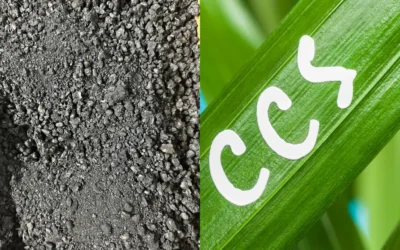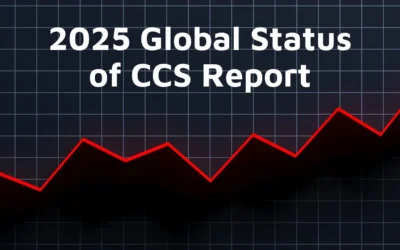Anna Jacobs
Why Photosynthesis is the Most Advanced Carbon Capture Technology Your Company Isn’t Using Yet
Every action we take—every mile we drive, every meal we eat—leaves a mark on the planet. For the average American, that mark adds up to 16 tons of CO2 emissions per year, one of the highest per capita rates in the world. But what if there were a way to not only offset your personal carbon footprint but also support farmers, regenerate soil, and create local jobs?
At Dynamic Carbon Credits, we believe carbon capture can be more than just a tool for fighting climate change – it can be a force for good. By turning the fight against emissions into an opportunity to heal the planet and empower communities, we’re redefining what it means to take responsibility for your impact.
As a sustainability leader, your world is a constant evaluation of the next frontier in climate tech. The conversation, and indeed the investment, is dominated by gleaming steel structures—Direct Air Capture (DAC) facilities promising to pull CO2 directly from the sky. These are vital, laudable innovations, and we applaud their development as part of a necessary portfolio of solutions. But in our collective search for a futuristic silver bullet, we have become strategically blind to the most powerful, sophisticated, and scalable carbon capture engine on the planet. It has been running for 3.5 billion years, covers millions of acres of our working lands, and is powered entirely by the sun. I’m talking about photosynthesis. The critical question for today’s corporate leader isn’t if we should use this technology. It’s how we can upgrade it for the demands of the 21st-century economy and climate crisis.
Part 1: Re-framing Photosynthesis as the Original DAC
It’s time to stop thinking of plants as just “nature” and start seeing them for what they are: a globally distributed network of self-replicating, solar-powered carbon capture devices. At Dynamic Carbon Credits, we call this powerful process DAC-P: Direct Air Capture via Plants. The performance specifications of this technology are staggering. Every year, terrestrial plants pull approximately 120 gigatons of carbon from the atmosphere. To put that in perspective, the entire global capacity of mechanical DAC facilities today is measured in the thousands of tons. Nature’s technology operates at a scale that is orders of magnitude beyond anything humans have yet engineered. Furthermore, its energy efficiency is unparalleled. While mechanical DAC is an energy-intensive process, often drawing power from a grid that is itself in transition, DAC-P runs on a clean, free, and abundant energy source: sunlight. So, if this technology is so effective, why are we facing a climate crisis? The issue has never been the core technology of photosynthesis itself. The problem is the “software” we’ve been running on our agricultural lands for the last century. Industrial farming practices—while maximizing for yield—created a leaky system. Constant tillage, exposed soil, and seasonal monocultures function like buggy code, causing the vast majority of captured carbon to be quickly re-released into the atmosphere through decomposition and soil degradation. The system is leaking, and the carbon balance is broken.
Part 2: The System Upgrade: Regenerative Agriculture & Biochar
A Fortune 500 company would never run its global operations on outdated, insecure software. Why should we treat our planet’s carbon cycle any differently? The solution lies in a critical system upgrade, composed of two key protocols that transform a leaky process into a secure and permanent one.
The ‘Permanence Protocol’: Biochar Carbon Removal
This is where we solve the single biggest challenge of traditional nature-based solutions: permanence. When a plant captures CO2, that carbon is part of a short-term biological cycle. When the plant dies and decomposes, most of that carbon returns to the atmosphere. Biochar fundamentally changes this equation. By taking the plant biomass—the physical result of photosynthesis—and heating it in a low-oxygen environment through a process called pyrolysis, we transform it. The process drives off volatile gases and leaves behind a stable, porous carbon structure that is highly resistant to decomposition. Think of it as hitting the ‘save’ button on the carbon cycle. This isn’t a theoretical concept; it’s a geological one. Biochar can lock away carbon in the soil for hundreds, even thousands of years. This transforms a temporary carbon sequestration into a permanent, measurable, and verifiable removal. For a corporation seeking to make credible net-zero claims, this distinction is everything. It’s the difference between a fleeting offset and a permanent asset on your climate ledger.
The ‘Efficiency Patch’: Regenerative Farming
If biochar is the ‘save’ button, regenerative agriculture is the software patch that optimizes the entire system. These are not just quaint farming techniques; they are essential protocols that enable the soil to function as the vast carbon sink it was meant to be. Practices like no-till farming prevent the physical disturbance of soil, keeping its complex carbon structures intact. Planting cover crops ensures the photosynthesis engine is running year-round, continuously drawing down CO2 while protecting the soil from erosion—a critical environmental threat in its own right. These methods rebuild organic matter, enhance the soil’s water-holding capacity, and create a healthier, more resilient ecosystem. They fix the leaks in the system, ensuring that more carbon stays in the ground, where it belongs.
Part 3: The Corporate Ledger: Why DAC-P is a Strategic Asset for the Fortune 500
For a Chief Sustainability Officer or Chief Financial Officer, a carbon credit is an asset. Its value is determined by its integrity, its verifiability, and its contribution to the bottom line. Here’s why our DAC-P approach creates a premium asset class for your sustainability portfolio.
Bulletproof Additionality
The principle of additionality is the bedrock of a credible carbon credit. It answers a simple question: did this carbon removal happen because of the investment, or would it have happened anyway? With our model, the answer is unequivocal. The revenue from the sale of carbon credits is what enables a farmer to make the significant investment required to transition to regenerative practices and, crucially, to fund the pyrolysis equipment to produce biochar. Without your company’s purchase, this specific, measurable, and permanent carbon removal would not have occurred. This direct, causal link is what separates high-integrity credits from the questionable offsets that are increasingly drawing fire from regulators and stakeholders.
De-risking Your Net-Zero Claims
In today’s climate of intense scrutiny, making a net-zero claim with low-quality offsets is a significant reputational risk. Greenwashing is no longer just a buzzword; it’s a material liability. By investing in permanent carbon removal through DAC-P and biochar, you are acquiring one of the highest-integrity credits on the market—one that is tracked, verified by third parties, and built on the unassailable principles of permanence and additionality. This is how you future-proof your sustainability claims against the audits and public scrutiny of tomorrow.
Beyond Carbon—The ESG Multiplier
A truly strategic investment delivers returns across multiple domains.
As our CEO, Beau Parmenter, often says, “True sustainability isn’t a single-entry ledger. Our credits represent permanent carbon removal, but they also represent restored soil, improved water security, and direct financial investment in the farming communities that are the backbone of our economy.”
This is the ESG multiplier effect. A single investment in a DAC-P credit delivers cascading benefits:
- Environmental:
Permanent carbon removal, mitigation of topsoil erosion, enhanced biodiversity, and improved water retention in agricultural lands. - Social:
Creation of new, diversified revenue streams for farmers across the country, strengthening rural economies and bolstering our food security. - Governance:
The use of transparent, third-party verified credits demonstrates robust corporate governance and a commitment to real, tangible impact over mere accounting exercises.
Conclusion: Investing in Nature’s Upgraded OS
The future of corporate carbon removal will not be a single solution, but a diversified portfolio of the best technologies available. While we continue to build the incredible carbon-sucking machines of tomorrow, we must not neglect to upgrade the powerful, efficient, and proven engine that already surrounds us.
By investing in high-integrity credits from Direct Air Capture via Plants, your company is not just offsetting emissions. You are funding a critical upgrade to nature’s operating system. It is an investment that delivers permanent carbon removal, de-risks your climate commitments, and builds a more resilient and sustainable future for us all.
Is your company ready to invest in the most advanced carbon capture technology on Earth? Let’s discuss how a portfolio of high-integrity DAC-P credits can accelerate your journey to true net-zero.






